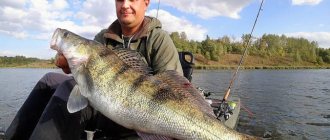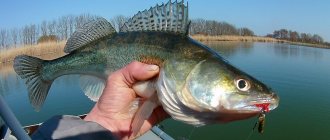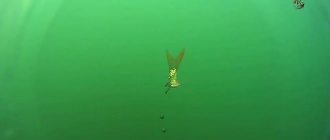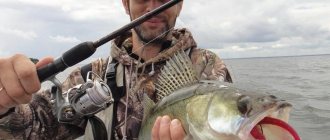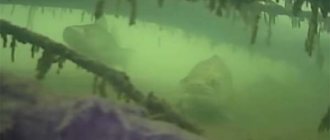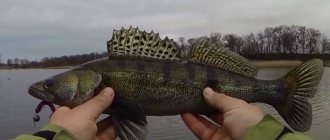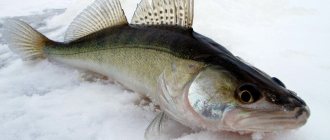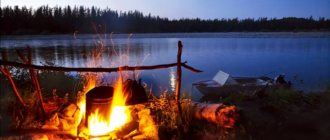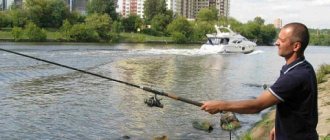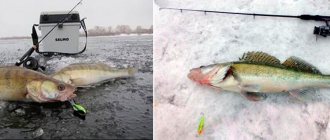Prokaev V. | April 13, 2002
The dependence of fish bite on weather and other natural phenomena is an eternal topic. It occupied a worthy place on the pages of various fishing publications a hundred years ago, it occupies it now and, undoubtedly, will occupy it in another hundred years. Probably nothing causes so much controversy and disagreement among fishermen. The revolutionary discoveries of scientists and the progress of technology make it possible to find answers to some questions, but new mysteries immediately appear, and their solution is sometimes not obvious.
Therefore, when choosing a route for an upcoming fishing trip, we are primarily guided by our own or others’ practical experience. And here many fishermen, and not only beginners, very often make a serious mistake in their reasoning.
Having formed an “absolute system of fish bite dependence” on the basis of a little personal experience or journal publications, people are fully confident that it will work everywhere and always. Alas, the deductive method when applied to fishing very often does not work! It is much more correct to go from the specific to the general, applying existing knowledge, adjusted for differences in fishing conditions. We sincerely hope that after reading this article, thoughtful fishermen will not give themselves unambiguous attitudes at the level of “pike perch won’t bite in the east wind,” but will be able to adapt the many years of experience of our Kaliningrad author Vladimir Prokaev to their reservoirs, which are not an exact copy of the Kaliningrad Bay, and located, perhaps, in other regions of the country...
My dacha is located on the very shore of the Kaliningrad Bay, so for the past 20 years, every weekend I have been fishing in this very reservoir. I focus on pike perch - this is my favorite fish. In a year, it is possible to catch about two hundred pike perch of “commercial” size with a spinning rod, a dozen of them are large (more than 6 kg). After each fishing trip for several years, I made notes in my diary, recording not only the catches, but also the weather conditions. Over time, I began to understand why sometimes the pike perch pecked “like a machine gun,” and sometimes completely ignored my bait, although the echo sounder showed fish in large quantities. I want to share these observations with the readers of the magazine.
We will look at weather events and other natural factors that I observed to draw conclusions. Everything that will be said concerns only the Kaliningrad Bay and applies exclusively to pike perch. I cannot speak with such precision about other fish, since for many years I was mainly interested in pike perch.
Naturally, despite the large volume of practical statistics, my observations cannot be considered the absolute truth, and therefore this article will be replete with words such as “perhaps,” “maybe,” “probably,” “I think,” etc. Impact natural phenomena on fish biting is a complex topic, no one can accurately answer all the questions that interest us at the present time, and, probably, not soon will anyone be able to firmly say: “this is exactly the way it is, and not otherwise.” I think everyone understands perfectly well that there can be no accuracy in predicting the bite for an upcoming fishing trip. Moreover, I honestly admit: in a number of cases the patterns I have derived give inexplicable failures, and sometimes it happens that in violation of all the rules, pike perch is sometimes caught, and sometimes not, and not a single fisherman can understand what it needs. And yet, in the vast majority of cases, my observations outlined below found practical confirmation.
reference Information
The Kaliningrad Bay (in Poland - Vistula Bay) has an area of 472 square meters. km, the average depth does not exceed 3 meters, the maximum is 5.2 meters. All the main spawning grounds for pike perch, bream, smelt and herring are located in the eastern part of the bay, which belongs to the Kaliningrad region.
Almost all year round, the water has a slight salty taste, and if during the summer the salinity is insignificant, then in the fall, with the predominance of westerly winds and the influx of water from the sea, the salinity of the bay increases. The normal water level in the bay is several centimeters above sea level, but with strong, prolonged winds it can rise by a meter.
In order for sea vessels to enter Kaliningrad, a sea canal 34 km long and 9 to 12 meters deep was dug on the northern side of the bay. When laying the canal, the soil was unloaded on one side, resulting in the formation of 12 artificial islands that stretch along the sea canal from Kaliningrad to the city of Baltiysk, where the sea canal connects with the sea. The islands are long, but narrow; if the length of each is several kilometers, then the width is only 20-30 meters. The banks are reinforced with cobblestones, which extend into the water 2-3 meters from the shore.
Spawning ban on fishing in the Kaliningrad region 2021
Spawning 2021 in the Kaliningrad region , dates where fishing is prohibited during the spring-summer spawning fishing ban. Designated places and dates for each reservoir.
Areas prohibited for the extraction (catch) of aquatic biological resources throughout the year:
in front of the mouths of the rivers Matrosovka, Nemonin, Deyma at a distance of less than 0.5 km to the right and left of the mouths and at a distance of 2 km or less into the bay along the fairway line;
in the Severnaya (Skirvit) River (with the exception of fishing grounds provided for the organization of amateur and sport fishing), as well as in all lakes and canals that have a hydrological connection with the Severnaya (Skirvit) River; in the Curonian Lagoon - from the village of Mysovka to the border with the Republic of Lithuania, at a distance of 3 km or less from the coastline; at a distance of 0.3 km or less from fixed fishing gear (or cages for growing and keeping fish) in the 26th subregion of the Baltic Sea, the Curonian and Vistula (Kaliningrad) Lagoons, as well as at a distance of 0.1 km or less on Lake Vishtynetskoye and rivers of the Kaliningrad region; in the 26th sub-region of the Baltic Sea, in the Kaliningrad and Curonian Lagoons, Lake Vishtynetskoye at night from floating craft. Terms (periods) prohibited for the extraction (catch) of aquatic biological resources:
In the 26th sub-region of the Baltic Sea:
from September 1 to November 30 - Atlantic salmon (salmon);
throughout the year - Atlantic salmon (salmon) - in a belt-wide water area with a radius of 1 nautical mile from the mouths of rivers flowing into the Baltic Sea.
In other water bodies of fishery importance in the Kaliningrad region:
a) from April 20 to June 20 (two-month period for the protection of spring-spawning fish species):
in the coastal zone of the Curonian Lagoon at a distance of 0.5 km from reed thickets, and in their absence - at the same distance from the coastline;
in the coastal zone of the Kaliningrad Bay at a distance of 0.5 km from reed thickets, and in their absence - at a distance of 1 km from the coastline;
in the Kaliningrad Bay - east of the line connecting Cape Tupoi (54°38'95" N 20°18'46" E) with the village of Vzmorye (54°41'37" N 20° 14'99" E);
in the Kaliningrad Sea Canal - from bulk islands, from floating craft (from the city of Kaliningrad to the ship repair yard in the city of Svetly);
in all rivers, canals of the Polesie and Slavsk regions, with the exception of the Deyma River and the Polesie Canal, where fishing from the shore is allowed;
in all lakes of the Polesie and Slavsk regions that have a hydraulic connection with rivers, as well as canals and channels connecting lakes with rivers;
in all floodplain lakes connected with the rivers Neman, Pregolya, Deyma and the Zelenograd Canal, as well as in canals and channels connecting these lakes with rivers;
in the Nelma River - from the mouth to 9 km upstream;
in the Prokhladnaya River with its tributaries and canals;
in the Zelenograd Canal - to the left branch of the Zelenogradka River;
in all other rivers and canals flowing into bays, at a distance of 2 km from the mouths upstream;
in the Neman River, its tributaries and branches, downstream from the fork of the Neman River with the Matrosovka River;
b) from October 1 to June 30 - catching crayfish;
c) from April 10 to May 31 in the Sheshupa River;
d) from April 10 to June 10 in Tikhaya Bay (Lake Vishtynetskoye), in other places - at a distance of 200 meters from the coastline;
e) spearfishing:
throughout the year: in Tikhaya Bay (Lake Vishtynetskoye) along the outer boundaries of fishing squares No. 51, 63 (Appendix No. 2 to the Fishing Rules “Fishing squares of Lake Vishtynetskoye”); the rivers Sheshupa, Instruch, Angrapa, Pissa, Krasnaya;
from April 20 to June 20 - on all other water bodies of fishing importance in the region;
f) from March 1 to April 10 - production (catch) of pike.
Types of aquatic biological resources prohibited for extraction (catch):
Atlantic salmon (salmon):
in rivers flowing into the Baltic Sea, their pre-estuary sections at a distance of 1 nautical mile or less from the coastline;
in the Curonian and Vistula (Kaliningrad) Lagoons and the rivers flowing into them.
Types of prohibited tools and methods of extraction (catch) of aquatic biological resources:
Prohibited:
a) application:
any enveloping and straining mining (catch) gear, with the exception of lifters (spiders) with a size of no more than 100 x 100 cm and a mesh size (pitch) of no more than 10 mm;
prison, traps;
electric current;
firearms and pneumatic weapons (except for shotguns and pistols for underwater hunting);
saddles;
any hooked fishing (catch) gear with a total number of hooks of more than 10 pieces on a citizen’s fishing (catch) gear. Double and other multi-pointed hooks are counted as one;
a citizen has more than five crayfish traps (the diameter of each crayfish trap is more than 80 cm and the mesh size (pitch) is less than 20 mm);
b) carry out production (catch):
method of purging (by hooking);
“for illumination”;
by installing driveways, fences, dams, partially or completely blocking the bed of water bodies of fishery importance and preventing the free movement of fish;
on the track (trolling) using a sail and a motor using more than two baits.
Name of minimum aquatic biological resources for catching in cm:
Asp 40 Pike-perch 40 Bream 25 Pike 32 Freshwater catfish 90 Carp 40 Burbot 40 Chub 20 Crayfish 10
Wind
According to my observations, the wind has a strong influence on the pike perch bite, even during periods of active biting - for example, before spawning, when, it would seem, pike perch should be caught in any weather. The post-spawning feast also suddenly stopped as soon as the wind changed its direction. Let me remind you once again that we are talking only about the Kaliningrad Bay; in other bodies of water, these laws may not work.
So the wind is blowing from the west. The wave goes along the islands. No matter how western the wind is, the waves still do not travel exactly parallel to the island - they roll onto the shore from one side or the other. If the wave is large and, most importantly, it has been hitting the shore for several days, fishing will not be so successful, although there will be bites. The thing is that the waves near the coastline form a strong turbidity in the water, which pike perch don’t really like. It either moves away from the shore, beyond the boundary of the muddy water, or stands still with its mouth closed and does not want to clog its gills with sand. At this time, the pike perch almost does not hunt, I repeatedly had hooks and hits on the fish (I pulled out one pike perch scale on a hook), but he did not pay attention to all the baits, even brightly colored ones.
If the westerly wind has just begun, and the waves have not had time to raise strong turbidity, the pike perch shows increased activity. Even if the wind is quite fresh, the bite is still usually good. Moreover, pike perch are often caught near the coastline - I think that they begin to collect weakened or slightly stunned small fish. Perhaps the fry simply cannot cope with the breaking wave, and the pike perch, using its agility, collects easy prey. I sometimes fished along the shore at a depth of no more than half a meter, and with the rolling wave it seemed that it would expose the bottom, but the pike perch took it, and took it well! At the same time, the wave was sometimes so strong that it did not even allow me to stand calmly near the shore - the splashes from hitting the stones reached my face.
If the wind begins to turn from west to south, then a lot depends on its strength. If the wind is moderate and creates only a slight disturbance, then the pike perch bite will stop only for a short period. The pike perch stops taking immediately at the moment the wind turns. This happens especially often in the spring. If the wind begins to turn from the west to the south, and the bites stop, then you shouldn’t stop fishing: about half an hour after the wind finishes its turn and knocks down the waves from the west, the bites will resume with renewed vigor. If the wind gets stronger and hits the rocks, the bites may stop altogether. According to my observations, when the wave goes perpendicular to the shore, the pike perch begins to move away from it, apparently afraid of being thrown ashore or hitting the rocks.
After the storm, especially in the spring, I repeatedly observed pike perch washed ashore. This happened while the pike perch was on the nest. It seems that those pike perch that survived the storm retain for a long time in their memory these unpleasant hours when the wave goes perpendicular to the shore. And if during spawning the pike perch still stands on the nest, then in normal times nothing stops it in the coastal zone. Usually the pike perch goes beyond the boundary of muddy water. I tried on a boat to move 100-150 meters from the shore and fish where there was no strong turbidity. Pike perch continued to be caught at such a distance from the shore, and very well. It is impossible to throw muddy water beyond the shore from the shore: usually this border is located 100-300 meters from the shore.
If the wind blows from the east, the bites usually stop immediately. In our region, on the Kaliningrad Bay, this is due to the environmental situation on the Pregola River flowing into the bay. With an easterly wind, the current in Pregol intensifies, the flow begins to wash out and carry into the bay from the bottom sediments from the discharges of pulp mills. They say that the layer of these sediments, accumulated over many years, is more than two meters. This nasty stuff is starting to wash out from the river into the bay. If the east wind blows for several days, then you should not look for pike perch closer to the village of Vzmorye; it has moved away from this nasty thing and will not return until the ox is cleaned. Therefore, with eastern winds, there may be no fishing at all, or it will be ineffective.
The wind turned to the north. An interesting pattern is noted here: if the wind turns through the west, then everything is fine, fishing will take place, but if the wind turns through the east, then problems with fishing may arise. Perhaps the fish has already remembered what the east wind carries, and it quickly breaks away from its places and does not return to them soon. If the wind turns to the west, then a calm forms behind the islands, and the small fish that walked along the islands from the side of the sea channel (northern side of the island) begins to hide from the waves on the opposite shore. At this time, it is necessary to pay special attention to gullies and breaks in the pillars of the coastal protection of the islands. Through them, small fish begin to move to the opposite side of the island, and in these places the pike perch is waiting for it.
Complete calm. Pike perch can be caught, but at this time they are very careful. The water is usually clear, the pike perch can clearly see not only our bait, but also everything that is happening on the shore. In addition, he can clearly hear the noise from stones on the shore or from a moving boat. In calm weather, I have almost never managed to catch large pike perch. They may have moved away from the suspicious noise, or stopped feeding, waiting for a better time.
The best time is when the winds blow from the west, south-west and north-west with low strength. It is better when there are not ripples on the water, but small waves 20-40 centimeters high, but the water should be quite clean. If there has been a storm recently, the boat will not approach the shore until the sand sinks to the bottom.
Flow
One of the most important factors influencing the pike perch bite in the bay is the strength and direction of the current. It especially affects fishing results when fishing from islands or from a boat in close proximity to them. The thing is that the water level in the bay is constantly changing: the western winds have blown - the water level begins to rise, even in the Pregola River at this time there is a reverse flow. So in the bay along the islands, if in a normal position, on the sea channel, a weak current goes towards the sea, then with a westerly wind it either stops completely or turns in the opposite direction, and the water quickly arrives from the sea.
The standard current, in which the fish in the bay live and feed in the usual way, is weak and constant towards the sea. If the current turns around and goes in the opposite direction, then the number of bites is sharply reduced, and sometimes they stop altogether. This is most likely due to a change in everything familiar in the water: the fish turns 180 degrees against the current, underwater vegetation also begins to turn in the other direction, turbidity begins to rise from the bottom, and the bottom topography is being restructured. You've probably observed that the sandy bottom looks like waves in the water, and so when the current changes, it begins to change its profile. On top of everything, the water level begins to rise, and, as you know, the fish react negatively to it. Therefore, when the current turns to the opposite direction, fishing, as a rule, is not very effective.
When the water in the bay and the Pregola River has risen much higher than standard and the wind has died down or turned in other directions, the water begins to recede (fall), and the flow towards the sea noticeably increases in comparison with the standard situation. The current at this time is observed not only in the sea channel, but also on the opposite side of the islands. Moreover, the trend is not universal; there is a clear demarcation. The greatest distance from the coast where I observed a noticeable current was 100 meters from the islands, then the current stopped. In this strip, successful fishing is unlikely - usually the stream does not contain a lot of debris, and the pike perch moves away from here.
If the current is constantly changing, going west or east, this will also not lead to frequent bites. Pike perch will be caught, but only small ones. With constant changes in current directions, the best bite occurs in those hours when there is no current at all. Let me note once again that usually the current in the sea channel is insignificant, that is, slow, so its absence as such does not lead to a decrease in the activity of pike perch.
Of all the possible options for currents along the islands, the most attractive for us occurs with gentle winds from the north. At the “gates” (gaps between the islands) or in the gullies of the breakwaters, the flow towards the bay begins. This is something you can’t help but pay attention to! Especially if the water is clean and carries fine suspended matter, and whirlpools form behind the breakwater pillars. In this place, as a rule, a lot of fry gather, which catch this suspension, and our pike perch, which stays on the border of calm water, does not lag behind them. The best direction for placing the bait in the “gates”, especially in those in which the fairway is dug, is along the slope (slope) into this fairway. Pike perch often makes unexpected runs from the depths onto the shallows, where the fry collects floating and washed-up food. Moreover, try to catch from one and then from the other side of the “gate”. It also happens that the current does not run exactly parallel to the island, and begins to carry floating small debris to one side or the other of the fairway. If this cannot be determined visually, then you just need to try fishing on both sides of the islands - perhaps there will be much more bites on one side. It is better to make casts at an acute angle along the drop, and not towards the fairway - this way you can fish a greater distance, and there is a higher chance that your bait will fall into the field of view of the pike perch.
Precipitation
We have precipitation in the Kaliningrad region often, and sometimes quite prolonged. In spring, as a rule, the rains are short, but often heavy and with thunderstorms. If a thundercloud is heading towards you, you shouldn’t get wet in the rain, waiting for the bite to improve - for some reason the pike perch doesn’t want to be caught, and it’s better to wait out the bad weather in a shelter. After the rain stops, the pike perch does not immediately resume its bites. I don’t know what this is connected with, but for about 20-30 minutes there is complete lack of biting, and then the biting resumes, as if there was no rain.
In summer, rain can completely ruin your fishing. When it starts to rain, the sky becomes cloudy and there are short squalls - at this time pike perch is almost never caught. If there is a prolonged drizzling rain for several days, then fishing will probably take place and be quite successful. In such rain, the bite strongly depends on the direction and strength of the wind: if the wind is gusty, then bites are unlikely, but if it is warm, there is little or no breeze, the pike perch continues to feed.
In autumn, drizzling rains sometimes fall without a break for two weeks. You get so used to them that you stop noticing them. So, probably, the pike perch is getting used to them - you can safely go fishing and expect pike perch bites, just like in good weather.
Concluding the topic of precipitation, I want to touch on one aspect that is not directly related to the bite of pike perch. When fishing in the Gulf, you should always pay attention to the movement of clouds, especially if you are fishing from a boat. The whole point is that before a thunderstorm there is often a squall, and you have to see what a squall that comes from the sea is. It is capable of pumping a wave up to a meter high in 10 minutes, but the most important thing is that small rubber boats cannot stay on their light anchors. It even happens that a low-power motor is not able to withstand the force of the wind, and the boat cannot move against the wind and begins to drift. It’s good if the wind is towards the shore, but it’s much worse when it’s from the shore - it can carry you very far! I once towed a boat equipped with a domestic “Salyut” - the “two-horse” engine turned out to be absolutely helpless in the face of the elements... The most important thing is that before a squall, the excitement on the water is sometimes completely absent, and the fishermen go far from the shore. A squall can overturn a light “inflatable” - you can guess the possible consequences. Fishing is fishing, but we must not forget about safety!
0
The most popular fishing destinations for predatory fish in the Kaliningrad region are: fishing for pike perch and perch in the Curonian and Kaliningrad Lagoons, as well as pike perch and cod in the Baltic Sea. For convenience, we will tell you what and how happens on reservoirs during the calendar year.
It should be noted right away that we catch cod all year round without interruption , only the size of the catch and the fish itself differ. The best season for cod is autumn-winter-spring; the sea does not freeze in winter. In the summer you just need to fish further away, but a dozen or so in the catch will be guaranteed. There were cases when summer catches were record high. Further in the text we will not dwell on cod.
January February
As a rule, in January and February the reservoirs are covered with ice. At this time you can catch pike perch and perch in the Kaliningrad Bay, perch in the Curonian Lagoon. We talked about winter fishing in this section. But it is possible that during these months or part of them there is no ice and you can fish with spinning rods in the Kaliningrad Bay and the rivers of the region. Pike, pike perch and perch are caught. At this time, fishing trips are not distinguished by large catches, but nevertheless, you can satisfy the fishing instinct by catching a couple of good fish and a few bass.
March
It happens that there is still ice in March, but this is rare. The pre-spawning period for fish begins. The water gradually warms up, the fish become more active, trying to gain a little more strength and fat before reproducing their own kind. At this time, catches of perch and pike perch in the Kaliningrad Bay reach several dozen individuals. Whole flotillas of fishing boats rush to the water. It happens that promising places are crowded.
From March 1 to April 10, due to spawning, there is a ban on pike fishing in the region.
April
In the Kaliningrad Bay, even before mid-April, the fish are active and by the third decade the bite subsides, the fish go to spawn. But in the Curonian Lagoon, the fish seem to wake up, remaining passive until then, gather for spawning grounds and try to accumulate fat before spawning. Fishing in the period late April - mid-May on the Curonian Lagoon is very catchy. Schooling perch and pike perch bite, and, unlike the Kaliningrad Bay, you don’t need to look for it, the places of concentration are known. From April 20 to June 20, a period of fishing ban begins in the Kaliningrad region. However, you can fish from boats in the bays, there are certain restrictions, but you can...
May
As mentioned above, in early May fishing on the Curonian Lagoon is very interesting. In the first ten days, perch is active, and by the beginning of the second ten days, when the perch stops biting, pike perch comes to the rocky banks. Around the beginning of the third decade, the Kaliningrad Bay comes to life, and the first messengers after spawning begin to peck in the center of the bay. By the end of May the bite intensifies.
June
Throughout June, fish gather in the bay near the strait into the sea. The schools of perch and pike perch are simply huge. The catches are nice, as is the size of the fish.
July
A significant part of the pike perch population rushes to the sea, where the water is rich in oxygen and there is a good food supply. There, from July to October, pike perch fattens, gaining weight. The time has come for almost the most popular fishing among Kaliningrad fishermen. A rare boat can be found in the bays, all at sea! Although the bite in the bays does not stop, there are still a lot of perch and pike perch, as practice shows, not all love the sea.
August
The situation described in the previous paragraph continues until mid-August. Excellent fishing continues in the sea, but the first messengers are already beginning to return to the bay. In the Baltiysk region, in famous places you can fish no worse than in the sea. This alternative is not bad in case of bad weather, because in the bay there is always somewhere to hide.
September October
During these months, it’s time for the “season” for pike perch. From the sea side it is concentrated at the entrance to the bay, and from the bay side at the entrance from the sea. Boat fleets in the area reach several hundred boats in good weather. The catches are numerous and the trophies are nice.
November
At sea, the pike perch bite stops. In the Kaliningrad Bay, fish disperse to wintering areas that are well known to fishermen. At this time, the perch catches are good, and the pike perch continues to pamper with its presence, although the nature of the bite changes to a more passive one. But the reduction of baits and smooth movements do their job.
December
The water temperature drops, and with it the metabolism of the fish. The catches are not the same as the month before, but you can always catch a few fish to eat and satisfy your instincts.
The only thing that can prevent fishing in the bays and sea is the weather. But you shouldn’t despair, because we have rivers: Pregolya, Deima, Matrosovka, Lava and even the Pravdinskoye Reservoir, where, if necessary, you can always find shelter from bad weather and have great fishing. Welcome!
Atmosphere pressure
This is perhaps the most favorite topic for fishermen: if there is no bite, they always say that the pressure has dropped, or, on the contrary, has risen, so the fish are not caught. Of course, this is the easiest way to find the cause of the lack of bite. According to my observations, changes in atmospheric pressure really have a strong impact on pike perch bites.
I started monitoring atmospheric pressure in 1992, when I purchased an echo sounder. When using it, I immediately noticed that there are days when the fish stands in a certain horizon in the middle layers of water - on such days the weakest bite was observed, and often there was none at all. I also tried to move the bait in the middle layers of water, but I achieved almost no results. As I later noticed, this changed the atmospheric pressure, and the fish, for unknown reasons, began to change their habitat depth. Perhaps she reacts this way to changes in pressure, perhaps she is affected by changes in the magnetic field, perhaps she has other reasons for this. I will only say unequivocally that with a sharp change in pressure and when the fish is standing in the middle layer of water, there will be no successful fishing.
If the echo sounder shows that the fish is standing at the very bottom or stretched across the entire layer of water, then you can hope for a good bite. Pike perch can be active when constant (no matter whether high or low) pressure lasts for several days.
Moon
The phases of the moon are perhaps the most interesting and mysterious phenomenon that affects the fish bite. Many fishing books say that if there is a full moon, then pike perch will not be caught. Is it so? Let's look at the situation in more detail.
So, today is a full moon, there is not a single cloud in the sky. What awaits us in this case? At dawn, fishing can even be very decent, just don’t leave early - you should fish after sunset, and perhaps you will be pleasantly surprised by the active bites. That is, the full moon will not disrupt our fishing, but on the contrary, it will intensify the evening bite. The moon helps not only you, but also the pike perch, which sees its victims better during the full moon. At this time, as a nocturnal predator, it uses not only the lateral line, but also vision, which most likely plays a vital role for the pike perch when hunting for small fish. Unlike pike, which lies in ambush while waiting for prey, pike perch is an active hunter; it often pursues its prey, and in pursuit, vision is the most important factor in success. So it turns out that evening dawn and night fishing during the full moon will be more successful, but this is if there are no clouds. If the sky is completely cloudy, then the influence of the moon on the bite will be invisible.
But at dawn on the days of the full moon, the earlier you go out on the water, the more successful the fishing will be. It is better if you arrive before dawn: the period of active zhora will be short-lived. During the full moon, pike perch had time to hunt well at night, since they could see well, and therefore were caught for a short time after dawn. And if on ordinary days pike perch is caught until 10-11 o’clock, then on a full moon - usually no more than one hour after dawn. By this time, the pike perch is full, and, as you know, well-fed animals do not hunt in the wild. Obviously, fishing will be very bad on full moon days if you come to catch pike perch during the day. The reason, again, is that the pike perch is full - it has already laid down on the bottom and calmly fallen asleep, bites are only possible if you hit the pike perch with the jig, and the retrieve will be very sluggish, barely moving along the bottom. Fishing at this time is not very successful, and on such days I usually switch to catching other fish.
All these observations are valid only in clear weather. If the sky is completely covered with clouds and the moon is not visible at night, then the pike perch does not have time to get enough during the night, and its morning hunt is delayed and lasts until about 10 hours.
The waxing and waning moon may also have some effect on the pike perch’s bite, but I didn’t notice such pronounced patterns as during the full moon.
You can read more about pike perch fishing in the Kaliningrad Bay in Vladimir Prokaev’s book “The Year of the Kaliningrad Fisherman,” which is currently being prepared for publication in the “Sports Fishing Library” series.
Kaliningrad Bay. Perch. Perch.
Last weekend we checked in on the Kaliningrad Bay again. We arrived at the shore of Balga literally half an hour before darkness, so it was no longer our destiny to get on the water that day. “Well, okay, today we’ll rest, and on Sunday we’ll go fishing,” that’s what we decided on, admiring the last rays of the setting star in the company of our friends.
https://s017.radikal.ru/i419/1509/6e/b54399e7e5d1.jpg
Before the sun had time to properly wake up, Max and I, already awakened and warmed up by morning coffee, rocked the boat once again and loaded all our simple belongings into it again. Without hesitation, we go to the places where we fished a week ago, not forgetting to take some rocks with us to build the next “golden point”. https://www.stariy-kordon.com/public/style_emoticons/default/smile.png On the very first cast I catch perch : “Again - twenty-five!” - flashes through my head and immediately my brother makes fun of me, saying you can put your club in the tube and go to bed. “Shhhhhhh, the Russians don’t give up!” We are trying to select tires, something seems to be starting to work out, but everything is somehow unsure and incomprehensible. It will scratch, toss, hint at its presence, but nothing more. A little later, Max was hit by a pike perch, and judging by the resistance, it wasn’t bad, but unfortunately, it got off near the boat. Then I came across a “watermelon”.
https://i016.radikal.ru/1509/1f/8fa2892c5704.jpg
We had a little fun around the Balgov hummocks and, using the “call a friend” function, i.e. Chan, we galloped along the waves in the direction of Nasypny. It’s more fun here, and there are more people, and no, no, and there will be a bite, sometimes loud, sometimes not very loud, sometimes empty, sometimes with a runt on a jig. We kept spinning and spinning in this area, and finally got around to it. The brother has a powerful blow, the fish comes towards us halfway the first half of the way, thereby convincing us that it is nothing serious. Then he abruptly changes his intentions and begins to break away to the fullest, with jerks, strong resistance and the traditional entry under the boat. But that’s not the case, we’re not cut out for it either, and now he’s the first worthy opponent this year, Max already has it in his hands! The scales showed 3.7 kg.
https://s008.radikal.ru/i303/1509/ea/9bcf8e2ac135.jpg
We continue our search in the same area, but we no longer come across anything except a few kids and one 48th border guard. We decide to return to the morning points. The first casts show that fish of the “perch” brand are present here. We managed to catch about five more perches and finally Neptune took pity on me and allowed me to grab a little adrenaline. On the next retrieve, the jig rests on a hummock; with a slight twitch of the brush, I help the bait to fall over it, and a blow follows immediately. Hooking, I feel like I hit someone in the mouth, but didn’t let me finish eating. I pick up the slack and do another light wrist toss. "Clack!" and someone's jaws closed on the bait. This pike perch behaved the same way as the previous one. At first he went to the meeting, then with his frequent and not strong trembling he reminded me of fishing for a perch, but now closer to the boat he showed who is who. Handsome, worthy fighter!
https://s013.radikal.ru/i322/1509/5f/699765e79d39.jpg
On this pleasant note, it was decided to call it a day with fishing for today. Last time I said that everything is just beginning on the Kaliningrad Bay, and so it is. Slowly but surely...https://www.stariy-kordon.com/public/style_emoticons/default/wink.png
